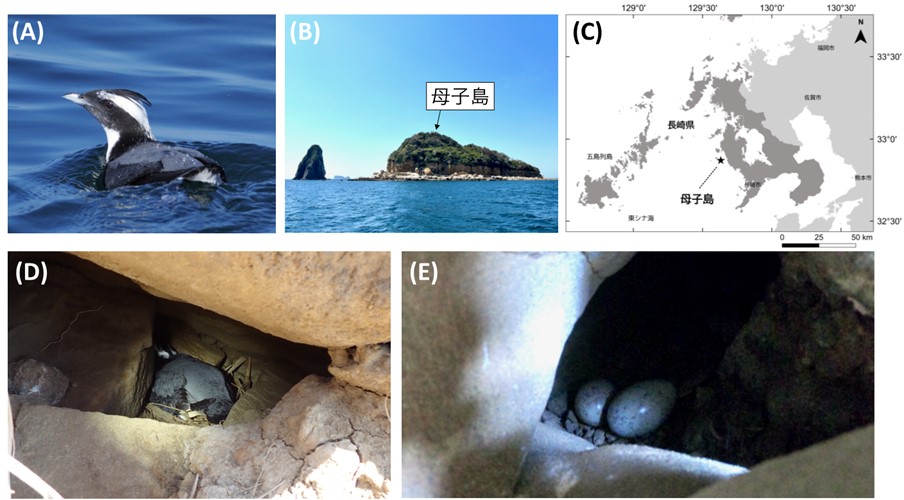April 22, 2024
New Breeding Site of Japanese Murrelet Synthliboramphus wumizusume, Found in Nagasaki, Japan
A research group led by Professor Noriyuki Yamaguchi of the Graduate School of Integrated Science and Technology at Nagasaki University and Curator Toru Nakahara of the Kitakyushu Museum of Natural History and Human History (Inochinotabi Museum) has discovered a new breeding site for the Japanese Murrelet Synthliboramphus wumizusume (Figure A), the most threatened alcids in the world declared a Japanese Natural Monument by the Agency for Cultural Affairs. Japanese Murrelet breed on uninhabited offshore islands, and their main breeding activity occurs at night, making it extremely difficult to find breeding sites.
■The newly discovered breeding site is Hahakojima, Nagasaki City, Nagasaki Prefecture (Figures B and C). This island is located in the Sumounada, East China Sea, about 4.5 km from the mainland.
■Identifying the breeding sites of the Japanese Murrelet can be challenging; however, with information from local bird watchers and individuals engaged in fishing and marine recreation, we were successful in locating the sites (refer to Figures D and E).
■The estimated worldwide population of the Japanese Murrelet is approximately 5,000-10,000, and breeding sites are known only along the southwestern coast of Japan and around the coast of Korea. It is said to be one of the rarest murrelets in the world, and understanding its previously unknown breeding sites will contribute to the conservation of the Japanese Murrelet and its habitat. Figure: (A) Japanese Murrelet (B) Panoramic view of Hahakojima (C) Location of Hahakojima (D) Parent Japanese Murrelet incubating its eggs (E)Eggs in the nest
Figure: (A) Japanese Murrelet (B) Panoramic view of Hahakojima (C) Location of Hahakojima (D) Parent Japanese Murrelet incubating its eggs (E)Eggs in the nest
■Research Background
Murrelets are seabirds that are primarily found in the northern part of the Northern Hemisphere. They tend to inhabit open sea areas and use cliffs and uninhabited islands for breeding purposes, making them rarely seen by humans.
The Japanese Murrelet is a rare species only found in the seas surrounding Japan. Its population is estimated to range from 5,000 to 10,000 individuals and has been declared a Japanese Natural Monument by the Agency for Cultural Affairs. They are categorized as Vulnerable on the International Union for Conservation of Nature (IUCN) Red List of Threated Species due to concerns about the decline in its population caused by oil pollution, fishing bycatch, and predation from non-native predators in its breeding sites. Only about 25 of the 41 reported breeding sites for the Japanese Murrelet are believed to be active, with most located on small uninhabited islands or islets and having only a few dozen to several hundred breeding pairs. There are several reports of rodents, cats, and crows invading these small breeding sites and causing serious predation damage. Protecting the Japanese Murrelet requires monitoring population changes, identifying predator invasions quickly, and preventing damage.
To achieve this goal, it is necessary to have a comprehensive understanding of the breeding sites of the Japanese Murrelets. Based on numerous observation reports from local bird watchers, fishermen, and ferry captains, we have discovered that the breeding site of the Japanese Murrelet is Hahakojima Island, Nagasaki City, Nagasaki Prefecture.
■ Significance of Research Results
In southwestern Japan, there are many small islands and islets that have not yet been studied where the Japanese Murrelet breeds. In particular, Nagasaki Prefecture, in addition to having many observations of the Japanese Murrelet, has the largest number of islands in Japan (more than 971, about 14% of all islands in Japan), and the possibility of finding breeding sites for the Japanese Murrelet which has been pointed out for some time. This finding will encourage the discovery of potential breeding sites for conservation.
Japanese Murrelets are known to spend most of their lives in the open ocean, only coming to land on their breeding sites to mate, lay, and incubate eggs. They even raise their young at sea. Their nests are located in crevices in rocks, and breeding activities, such as egg-laying shifts, take place at night. Therefore, it is impossible to determine whether they are breeding by observing islands and crevices in rocks during the daytime.
Local residents played an indispensable role in helping us find the breeding site along the coast of Nagasaki Prefecture. Bird watchers and liner captains provided crucial information about the presence of the Japanese Murrelets during the breeding season. The captains who ferry night fishermen informed us about the abundance of small seabirds around Hahakojima at night. This information from the general public can lead to the protection of rare species, such as the government's designation of a protected area.
We also learned that crows prey on eggs and parent Japanese Murrelets on Hahakojima. Therefore, surveys and research will be conducted to determine the extent of the damage and take necessary protection measures.
■Publication Information
Title: Discovery of a new breeding site for the endangered Japanese Murrelet Synthliboramphus wumizusume in Nagasaki, Japan. Marine Ornithology 52: 23–26.
Author: Noriyuki M. Yamaguchi, Takayasu Amano, Tomomi Kimura, Ryu-Ichi Mine, Kosuke Otsuki, Emi Yamaguchi and Toru Nakahara (2024)
URL:http://www.marineornithology.org/article?rn=1555










